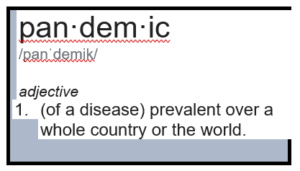At this point most Americans would settle for a federal government that might work at least as well as the local Costco, food pantry or grocery store: setting reasonable safety rules and providing most of what people need.
These are tough times for the twin ideas that the United States is a “can do” nation and beacon of individual rights. Rather than serving as a model for the rest of the world, the aggressive federal response to protests in Portland and regressive efforts to deal with the wildfire-spread of Covid-19 surely creates more pity from other populations than envy.
Our inability to put reasonable controls on individuals to deter them from spreading the virus has made an American passport partly useless. Our neighbors to the north and south don’t really want us to come across their borders: a denial of visiting rights that extends to many other nations as well. And who can blame them? Leadership from the federal government mostly lacks the will to use its powers on behalf of the safety of its citizens: the most basic kind of malfeasance. The withering of a federal response to the pandemic has left the task of guaranteeing access to even the most elemental of services to many ill-prepared states and cities. This doesn’t necessarily describe all government employees or members of Congress. Instead, the problem is with too many passive leaders at the top. And so—with some exceptions–we still lack timely virus testing, income maintenance for many workers left unemployed, protections for small businesses, and too little help for families on the edge of homelessness or caught in the grip of poverty.
Kids are now the political instruments of choice for an administration that craves the appearance of normalcy.
Even so basic a process of guaranteeing citizens an education comes down to a non-nuanced policy that simply says “open your doors,” even though many parents and communities are struggling to keep their families safe. Kids are now the political instruments of choice for an administration that craves the appearance of normalcy. At this point most Americans would settle for a federal government that might work at least as well as the local Costco, food pantry or grocery store: setting reasonable safety rules and providing most of what people need.
Another contagion has also spread through the country from the Trump administration or its followers: dangerous health advice and semi-official conspiracy theories about the origins of the virus, the presence of allegedly corrupt voters, unpatriotic activists, “fake news” Democrats, “the media” and even the federal government’s own experts. Reasonable evidence-based judgments are too painstaking and exact for the frail intellects that now populate the ranks of political appointees in Washington and some of the states. What some leaders want to believe now easily out distances what the facts should oblige them to accept.
Of course, the very wealthy are going to be ok. Having abandoned city houses for second homes, many are prepared to hire private tutors in lieu of sending their children into harm’s way. The ability of some of us to buy our way to safety is a reminder of economist John Kenneth Galbraith’s famous observation about the United States: that it tolerates private wealth even in the presence of public squalor. His description perhaps explains why so many Americans like to visit Europe, where the costs of functioning health care and public services are often built into the tax structure. We love cities like Amsterdam or Stockholm because fundamental infrastructures are in place, more or less, for everyone. Even through this pandemic some countries have worked to secure the future viability of schools, small businesses, arts organizations, public broadcasters and universities. In terms of similar cultural cornerstones here, we have yet to see how bad the American retreat from the core obligations of a civil society will be.
![]()

